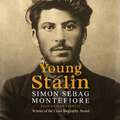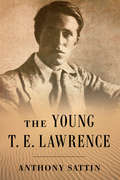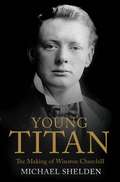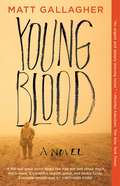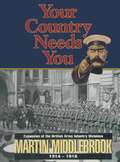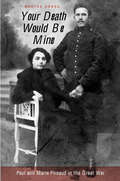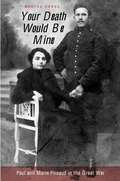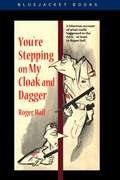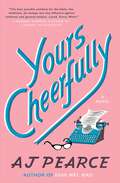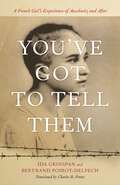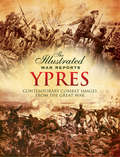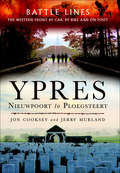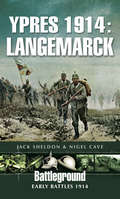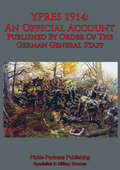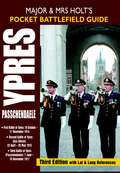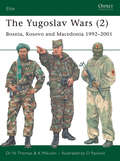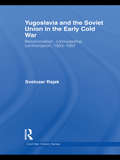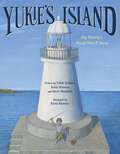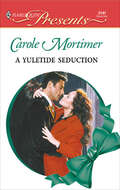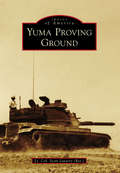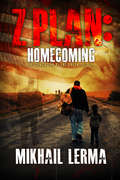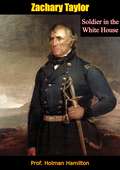- Table View
- List View
Young Stalin
by Simon Sebag MontefioreWinner of the Costa Biography AwardWhat makes a Stalin? Was he a Tsarist agent or Lenin's bandit? Was he to blame for his wife's death? When did the killing start? Based on revelatory research, here is the thrilling story of how a charismatic cobbler's son became a student priest, romantic poet, prolific lover, gangster mastermind and murderous revolutionary. Culminating in the 1917 revolution, Simon Sebag Montefiore's bestselling biography radically alters our understanding of the gifted politician and fanatical Marxist who shaped the Soviet empire in his own brutal image. This is the story of how Stalin became Stalin.Read by Sean Barrett(p) 2007 Orion Publishing Group
The Young T. E. Lawrence
by Anthony SattinAn intimate biography of the years that turned T. E. Lawrence into Lawrence of Arabia. Lawrence of Arabia's heroism during the Arab revolt and his disgust at the subsequent betrayal of the Arabs in the postwar negotiations have become the stuff of legend. But T. E. Lawrence's adventures in the Levant began long before the outbreak of war. This intimate biography is the first to focus on Lawrence in his twenties, the untold story of the awkward archaeologist from Oxford who, on first visiting "The East," fell in love with Arab culture and found his life's mission. Few people realize that Lawrence's classic autobiography, Seven Pillars of Wisdom, was not the first book to carry that iconic title. Lawrence himself burned his original draft. Anthony Sattin here uncovers the story Lawrence wanted to conceal: the truth of his birth, his tortuous relationship with a dominant mother, his deep affection for an Arab boy, and the personal reasons that drove him from student to spy. Drawing on surviving letters, diaries, and accounts from close confidantes, Sattin brings a biographer's eye for detail and a travel writer's verve to Lawrence's extraordinary journeys through the region with which his name is forever connected. In a masterful parallel narrative, The Young T. E. Lawrence charts the maturation of the man and the incipient countries he treasured, both coming of age at a time when the world's foundations were coming undone.
Young Titan: The Making Of Winston Churchill
by Michael SheldenMost people today think of Winston Churchill as simply the wartime British bulldog - a jowly, cigar-chomping old fighter demanding blood, sweat and tears from his nation. But the well-known story of the elder statesman has overshadowed an earlier part of his life that is no less fascinating, and that has never before been fully told. It is a tale of romance, ambition, intrigue and glamour in Edwardian London, when the city was the centre of the world, and when its best and brightest were dazzled by the meteoric rise to power of a young politician with a famous name and a long aristocratic background.Winston Churchill gave his maiden speech in Parliament at the very beginning of King Edward VII's reign in 1901 when he was only 26. By the time the guns of August 1914 swept away the Edwardian idyll, he was First Lord of the Admiralty - the civilian head of the largest navy in the world. In the intervening years, he often cut a dashing figure, romancing several society beauties, tangling with some of the most powerful political figures of his time, championing major social reforms, becoming one of the leading orators of the day, publishing six books, supervising an armed assault on anarchists, and working harder perhaps than anyone else to prepare his nation for war.
Youngblood: A Novel
by Matt Gallagher&“An urgent and deeply moving novel&” (Michiko Kakutani, The New York Times) about a young American soldier struggling to find meaning during the final, dark days of the War in Iraq.The US military is preparing to withdraw from Iraq, and newly minted lieutenant Jack Porter struggles to accept how it’s happening—through alliances with warlords who have Arab and American blood on their hands. Day after day, Jack tries to assert his leadership in the sweltering, dreary atmosphere of Ashuriyah. But his world is disrupted by the arrival of veteran Sergeant Daniel Chambers, whose aggressive style threatens to undermine the fragile peace that the troops have worked hard to establish. As Iraq plunges back into chaos and bloodshed and Chambers’s influence over the men grows stronger, Jack becomes obsessed with a strange, tragic tale of reckless love between a lost American soldier and Rana, a local sheikh’s daughter. In search of the truth and buoyed by the knowledge that what he finds may implicate Sergeant Chambers, Jack seeks answers from the enigmatic Rana, and soon their fates become intertwined. Determined to secure a better future for Rana and a legitimate and lasting peace for her country, Jack will defy American command, putting his own future in grave peril. For fans of Phil Klay’s Redeployment or Ben Fountain’s Billy Lynn’s Long Halftime Walk, Youngblood provides startling new dimension to both the moral complexity of war and its psychological toll.
Your Country Needs You: Expansion of the British Army Infantry Divisions, 1914–1918
by Martin MiddlebrookTaking the politics of Field Marshal Lord Kitchener's appointment as War Minister as his starting point, the author describes in his lively and authoritative style the dramatic events and dynamic personalities key to the ever-deepening British commitment. The reader is skilfully guided through the early mobilisation, dispatch of the British Expedition Force, withdrawal of overseas garrisons and the response from the Territorial Army. At the same time, Kitchener's now legendary appeal to the civilian population produced 'The New Army'.
Your Death Would be Mine: Paul and Marie Pireaud in the Great War
by Martha HannaPaul and Marie Pireaud, a young peasant couple from southwest France, were newlyweds when World War I erupted. With Paul in the army from 1914 through 1919, they were forced to conduct their marriage mostly by correspondence. Drawing upon the hundreds of letters they wrote, Martha Hanna tells their moving story and reveals a powerful and personal perspective on war. Civilians and combatants alike maintained bonds of emotional commitment and suffered the inevitable miseries of extended absence. While under direct fire at Verdun, Paul wrote with equal intensity and poetic clarity of the brutality of battle and the dietary needs (as he understood them) of his pregnant wife. Marie, in turn, described the difficulties of working the family farm and caring for a sick infant, lamented the deaths of local men, and longed for the safe return of her husband. Through intimate avowals and careful observations, their letters reveal how war transformed their lives, reinforced their love, and permanently altered the character of rural France. Overwhelmed by one of the most tumultuous upheavals of the modern age, Paul and Marie found solace in family and strength in passion. Theirs is a human story of loneliness and longing, fear in the face of death, and the consolations of love. Your Death Would Be Mine is a poignant tale of ordinary people coping with the trauma of war.
Your Death Would Be Mine: Paul and Marie Pireaud in the Great War
by Martha HannaPaul and Marie Pireaud, a young peasant couple from southwest France, were newlyweds when World War I erupted. With Paul in the army from 1914 through 1919, they were forced to conduct their marriage mostly by correspondence. Drawing upon the hundreds of letters they wrote, Martha Hanna tells their moving story and reveals a powerful and personal perspective on war. Civilians and combatants alike maintained bonds of emotional commitment and suffered the inevitable miseries of extended absence. While under direct fire at Verdun, Paul wrote with equal intensity and poetic clarity of the brutality of battle and the dietary needs (as he understood them) of his pregnant wife. Marie, in turn, described the difficulties of working the family farm and caring for a sick infant, lamented the deaths of local men, and longed for the safe return of her husband. Through intimate avowals and careful observations, their letters reveal how war transformed their lives, reinforced their love, and permanently altered the character of rural France. Overwhelmed by one of the most tumultuous upheavals of the modern age, Paul and Marie found solace in family and strength in passion. Theirs is a human story of loneliness and longing, fear in the face of death, and the consolations of love. Your Death Would Be Mine is a poignant tale of ordinary people coping with the trauma of war.
Your Travel Guide to Civil War America
by Nancy DayThis book takes readers on a journey back in time in order to experience life during the Civil War, describing clothing, accommodations, food, local customs, transportation, a few notable personalities, and more.
You're Stepping on My Cloak and Dagger
by Roger HallWith a sharp eye and wry wit, Roger Hall recounts his experiences as an American Army officer assigned to the Office of Strategic Services (OSS) during World War II. First published in 1957 to critical and popular acclaim, his book has become a cult favorite in intelligence circles. The story follows Hall's experiences from a junior officer fleeing a tedious training assignment in Louisiana to his quirky and rigorous OSS training rituals in the United States, England, and Scotland. Quick to pick up on the skills necessary for behind-the-lines intelligence work, he became an expert instructor. But he was only reluctantly given operational duties because of his reputation as an iconoclast. In his droll story-telling style, Hall describes his first parachute jump in support of the French resistance as a comedy of errors that terminated prematurely. His last assignment in the war zone came when William Colby appointed him section head of an operations group that made its way on foot through Sweden. Called one of the funniest and most perceptive works ever written about life in the OSS, the book includes a wealth of unforgettable personalities that Hall encountered over the years.
Yours Cheerfully: A Novel (The Emmy Lake Chronicles #2)
by AJ PearceFrom the author of the &“jaunty, heartbreaking winner&” (People) and international bestseller Dear Mrs. Bird, a new charming and uplifting novel set in London during World War II about a plucky aspiring journalist.London, November 1941. Following the departure of the formidable Henrietta Bird from Woman&’s Friend magazine, things are looking up for Emmeline Lake as she takes on the challenge of becoming a young wartime advice columnist. Her relationship with boyfriend Charles (now stationed back in the UK) is blossoming, while Emmy&’s best friend Bunty, still reeling from the very worst of the Blitz, is bravely looking to the future. Together, the friends are determined to Make a Go of It. When the Ministry of Information calls on Britain&’s women&’s magazines to help recruit desperately needed female workers to the war effort, Emmy is thrilled to be asked to step up and help. But when she and Bunty meet a young woman who shows them the very real challenges that women war workers face, Emmy must tackle a life-changing dilemma between doing her duty and standing by her friends. Every bit as funny, heartwarming, and touching as Dear Mrs. Bird, Yours Cheerfully is a celebration of friendship—a testament to the strength of women and the importance of lifting each other up, even in the most challenging times.
You’ve Got to Tell Them: A French Girl's Experience of Auschwitz and After
by Ida Grinspan Bertrand Poirot-Delpech Charles B. PotterOn a quiet winter night in 1944, as part of their support of the Third Reich’s pogrom of European Jews, French authorities arrested Ida Grinspan, a young Jewish girl hiding in a neighbor’s home in Nazi-occupied France. Of the many lessons she would learn after her arrest and the subsequent year and a half in Auschwitz, the most notorious concentration camp of the Holocaust, the first was that “barbarity enters on tiptoes . . . [even] in a hamlet where everything seemed to promise the peaceful slumber of places forgotten by history.”Translated by Charles B. Potter, You’ve Got to Tell Them is the result of a friendship that formed in 1988, when Grinspan returned to visit Auschwitz for the first time since 1945 and where she met Bertrand Poirot-Delpeche, a distinguished writer for the Paris newspaper Le Monde. Sometimes speaking alone, sometimes speaking in close alternation, Grinspan and Poirot-Delpeche simultaneously narrate the story of her survival and the decades that followed, including how she began lecturing in schools and guiding groups that visited the death camps. Replete with pedagogical resources including a discussion of how and why the Holocaust should be taught, a timeline, and suggestions for further reading, Potter’s expert translation of You’ve Got to Tell Them showcases a clear and moving narrative of a young French girl overcoming one of the darkest periods in her life and in European history.
Ypres: Contemporary Combat Images from the Great War (The Illustrated War Reports)
by Bob CarruthersThis powerful collection, depicting the grim realities of the four-year struggle for the Ypres salient, showcases the work of the contemporary combat artists and illustrators from the Great War era. Included here are the works of serious artists, propagandists, illustrators and humourists. The result is a stunning and vivid graphic record of life and death in the most infamous campaign of the Great War, as reported to contemporary audiences at a time when the events of the Great War were still unfolding. During the Great War artists and illustrators produced a highly accurate visual record of the fleeting moments the bulky cameras couldn't reproduce. These works form a body ofwar reportage that are as valid as the written word. Today, the work of the combat illustrators and the official war artists from the Great War era is overlooked by historians in favour of photographs, but these illustrations are nonetheless important, as they provide a contemporary record of hand-to-hand fighting, trench raids, aerial dogfights, sea battles, desperate last stands, night actions and cavalry charges
Ypres: Nieuwpoort to Ploegsteert (Battle Lines: The Western Front By Car, By Bike and On Foot)
by Jon Cooksey Jerry MurlandBattle Lines Ypres, the first volume in Pen & Swords new series of walking, cycling and driving guides to the Western Front, is the essential companion for every visitor to the Ypres Salient and the battlefields of Belgium. Many of the most famous - and most memorable - Great War sites are featured here. Expert guides Jon Cooksey and Jerry Murland take visitors over a series of routes that can be walked, biked, or driven, explaining the fighting that occurred in each place in vivid detail. They describe what happened, where it happened, and why, and who was involved, and point out the sights that remain there for the visitor to see. Their accounts give a fascinating insight into the landscape of the front line and the acts of war that took place there a century ago.
Ypres 1914: Langemarck (Battleground Early Battles 1914 Ser.)
by Nigel Cave Jack SheldonThese three Battleground Europe books on Ypres 1914 mark the centenary of the final major battle of the 1914 campaign on the Western Front. Although fought over a relatively small area and short time span, the fighting was even more than usually chaotic and the stakes were extremely high. Authors Nigel Cave and Jack Sheldon combine their respective expertise to tell the story of the men British, French, Indian and German - who fought over the unremarkable undulating ground that was to become firmly placed in British national conscience ever afterwards.When, in October 1914, the newly created German Fourth Army attacked west to seize crossings over the Yser, prior to sweeping south in an attempt to surround the BEF, two things prevented it. To the north, it was the efforts of the Belgian army, reinforced by French troops, coupled with controlled flooding of the polders but, further south, the truly heroic defence of Langemarck, for three days by the BEF and then by the French army, was of decisive importance. The village stood as a bulwark against any further advance to the river or the town of Ypres. Here the German regiments bled to death in the face of resolute Allied defence and any remaining hope of forcing a decision in the west turned to dust.
YPRES 1914: An Official Account Published By Order Of The German General Staff
by The German General Staff"An official German account, written close to the action, of the early Great War battles of the Yser and first Ypres in the autumn of 1914. Interesting revelation of German attitudes to the two battles that stopped their steamroller advance through Flanders.The full title of this book is "The Battle of the Yser and of Ypres in the Autumn 1914" and it gives equal coverage to both. It was written by a Captain Otto Schwink, a General Staff Officer, in 1917 - too close in time to the operations it describes to have permitted proper research and so provide a more objective account. It was intended primarily for public consumption and was how the German General Staff wished the campaign to be seen. Nevertheless, it is interesting to read the other side's point of view and balance is to some extent restored by the series of footnotes provided throughout the narrative by our own Historical Section (Military Branch)."--N&M Press Reprint
Ypres Passchendaele: 1st Ypres; 2nd Ypres (Gas Attack); 3rd Ypres (Passchendaele) 4th Ypres (The Lys) (Major & Mrs Holt's Pocket Battlefield Guide)
by Tonie Holt Valmai HoltA guide to these historic Belgian landmarks of the First World War, with maps and photos. Covering the Battles of Ypres, including the notorious Passchendaele, this guidebook takes readers on a historic trip through some of the best-known and most important sites of the area in Belgium. Part of a series of guides, it serves as an introduction to the historic battlefields, whether on the ground or from an armchair. Included are selections from the Holts' more detailed guides of the most popular and accessible sites, many full color maps and photographs, and detailed instructions on what to see and where to visit.
The Yugoslav Wars
by Darko Pavlovic Nigel Thomas K. MikulanOsprey's examination of Bosnia, Kosovo and Macedonia's involvement in the Yugoslav Wars (1991-1995), as well as their involvement in the conflicts of the years that followed. Following the death of the Yugoslavian strongman President Tito in 1980, the several semi-autonomous republics and provinces that he had welded into a nation in 1945 moved inexorably towards separation. As the world watched a series of wars ripped through this modern European state. In this second of two volumes, experts on the Balkan region give an unprecedented, clear and concise explanation of the armies of the the Bosnian Civil War 1992-5 as well as the conflicts in Kosovo and Macedonia. This includes the regular and militia forces which fought in these campaigns and which ultimately resulted in the UN/NATO policing of the region that continues to this day. The book is illustrated with rare photos and an extraordinary range of colour uniform plates.
Yugoslavia and the Soviet Union in the Early Cold War: Reconciliation, comradeship, confrontation, 1953-1957 (Cold War History)
by Svetozar RajakThis book provides a comprehensive insight into one of the key episodes of the Cold War – the process of reconciliation between Yugoslavia and the Soviet Union. At the time, this process had shocked the World as much as the violent break-up of their relations did in 1948. This book provides an explanation for the collapse of the process of normalization of Yugoslav-Soviet that occurred at the end of 1956 and the renewal of their ideological confrontation. It also explain the motives that guided the two main protagonists, Josip Broz Tito of Yugoslavia and the Soviet leader Nikita Sergeevich Khrushchev. Based on Yugoslav and Soviet archival documents, this book establishes several innovative theories about this period. Firstly, that the significance of the Yugoslav-Soviet reconciliation went beyond their bilateral relationship. It had ramifications for relations in the Eastern Bloc, the global Communist movement, and on the dynamics of the Cold War world at its crucial juncture. Secondly, that the Yugoslav-Soviet reconciliation brought forward the process of de-Stalinization in the USSR and in the Peoples’ Democracies. Thirdly, it enabled Khrushchev to win the post-Stalin leadership contest. Lastly, the book argues that the process of Yugoslav-Soviet reconciliation permitted Tito to embark, together with Nehru of India and Nasser of Egypt upon creating the new entity in the bi-polar Cold War world – the Non-aligned movement. This book will be of interest to students of Cold War History, diplomatic history, European history and International Relations in general. Svetozar Rajak is a lecturer at the London School of Economics and Political Science. He is the Managing Director of the LSE Cold War Studies Centre and is a member of the Editorial Board of the journal Cold War History.
Yugoslavia in the Shadow of War
by John Paul NewmanThe Yugoslav state of the interwar period was a child of the Great European War. Its borders were superimposed onto a topography of conflict and killing, for it housed many war veterans who had served or fought in opposing armies (those of the Central Powers and the Entente) during the war. These veterans had been adversaries but after 1918 became fellow subjects of a single state, yet in many cases they carried into peace the divisions of the war years. John Paul Newman tells their story, showing how the South Slav state was unable to escape out of the shadow cast by the First World War. Newman reveals how the deep fracture left by war cut across the fragile states of 'New Europe' in the interwar period, worsening their many political and social problems and bringing the region into a new conflict at the end of the interwar period.
Yukie's Island: My Family's World War II Story
by Yukie Kimura Kōdo Kimura Steve SheinkinA moving picture book autobiography about a family’s resilience and path to healing after the devastation of war. It's 1945, the final year of World War II. Yukie Kimura is eight years old. She lives on a tiny island with a lighthouse in the north of Japan with her family, and she knows that the fighting that once felt so far away is getting closer. Mornings spent helping her father tend to the lighthouse and adventuring with her brother are replaced by weeks spent inside, waiting. At some point, Yukie knows, they may be bombed. Then, it happens. One Sunday, bombs are dropped. The war ends soon after that. Everyone tells Yukie there's nothing to be scared of anymore, but she's not so sure. So she watches and she waits—until a miraculous sight finally allows her to be a kid again. This is the true story of Yukie Kimura told in her own words, co-created with her son, illustrator Kodo Kimura, and co-written with bestselling Newbery Honor author Steve Sheinkin. Yukie's Island is an honest, thoughtful, and stirring picture book about being a child living through wartime.
A Yuletide Seduction (Christmas Ser. #17)
by Carole MortimerEverybody knows her as Jane Smith—a successful businesswoman. What they don’t know is that Jane has also successfully distanced herself from her past.Until she meets handsome American Gabriel Vaughan at a Christmas party. Gabe’s determined to get close to her, seduce her and sooner or later he’ll recognize her…as a former society lady with a secret…
Yuma Proving Ground (Images of America)
by Lt. Col. (Ret.)The Yuma Proving Ground's early history began in 1849 with the establishment of Army outposts in the region. When the United States entered World War II in 1942, the Army established a large-scale training center that expanded from eastern California into western Arizona. Gen. George S. Patton Jr. was assigned to develop the Desert Training Center as a location to train personnel and test equipment in the harsh desert for the war effort. As part of the Desert Training Center, Camp Laguna and the Yuma Test Branch were founded to conduct specific training and testing in support of the war effort. In 1951, the Yuma Test Branch was renamed the Yuma Test Station, and by 1957, the Army began training personnel on military freefall. In 1963, the Army renamed the Yuma Test Station as the Yuma Proving Ground. Today, the Yuma Proving Ground stands near the original sites with the continued task of testing equipment and training personnel.
Z
by Vassilis VassilikosThe story of a political murder and the corruption of a ruthless and powerful military regime in a novel charged with anger, passion and suspense.
Z Plan: Homecoming (Z Plan Trilogy #3)
by Mikhail LermaAfter surviving an odyssey through zombie hordes, an American soldier faces the ultimate trial as he returns home in this apocalyptic series finale. Facing death and fighting the undead, Cale has made a seemingly impossible journey through the Iraqi desert and across dangerous oceans. All the while, he dreamed of reaching his home in America. Now, as that dream finally comes true, Cale discovers a nightmarish reality.In the thrilling conclusion of the Z Plan Trilogy, Cale’s limits are put to the final test as he pushes his way through the undead. But something even more sinister follows his every move. In a world where the weak die and every glimmer of hope seems extinguished, Cale’s toughest challenge will be to overcome his inner demons.
Zachary Taylor: Soldier in the White House (Zachary Taylor #2)
by Prof. Holman HamiltonThis tome is the second volume of Holman Hamilton’s landmark biography of Zachary Taylor (1784-1850), the 12th President of the United States. It examines Taylor’s brief but important political career and traces Taylor’s life from his return to the U.S. in December of 1847 from the bloody Mexican battlefields, to his death on July 9, 1850, a mere sixteen months after assuming the office of the presidency.As interesting as the history surrounding Zachary Taylor’s life is the man himself. Taylor was no politician. Throughout his life, he never voted in an election. He knew little of the party that nominated him. And he candidly admitted no opinion on certain political questions, and on others was reluctant to comment at all. At the end of his famous Allison letter that secured him the presidency in 1848, he stated: “I do not know that I again shall ever write upon the subject of national politics.” How and why he was elected President are just some of the questions that Hamilton answers about one of America’s most unusual presidencies.Zachary Taylor: Soldier in the White House is the sequel to Zachary Taylor Soldier of the Republic. Together, both volumes represent what is considered by historians to be the definitive biography of the 12th President of the U.S. Lauded for his meticulous research and highly readable style, the late Holman Hamilton, a noted journalist and editor, set out to “write entertainingly and even artistically about men and events in the realm of actuality.” Both volumes of this extraordinary biography are ample proof that he accomplished his goal.
